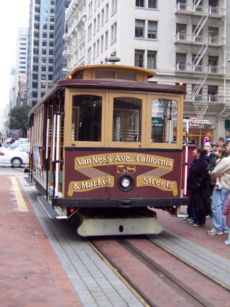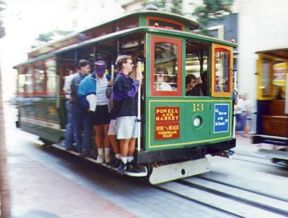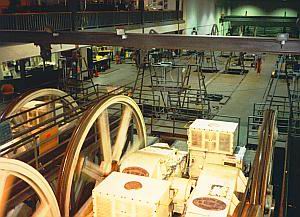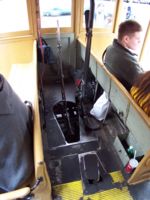San Francisco cable car system
| San Francisco Cable Cars | |
|---|---|
| (U.S. National Historic Landmark) | |
| | |
| Location: | San Francisco, California |
| Built/Founded: | 1873 |
| Architect: | Hallidee,Andrew |
| Architectural style(s): | No Style Listed |
| Added to NRHP: | October 15, 1966 |
| Reference #: | 66000233 [1] |
| Governing body: | Local |
The San Francisco cable car system is the world's last permanently operational manually-operated cable car system, and is now an icon of the city of San Francisco in California.
The cable car system forms part of the intermodal urban transport network operated by the San Francisco Municipal Railway, or Muni as it is better known. While the cable cars are used to a certain extent by commuters, their low speed, small service area, and premium fares make them primarily a tourist attraction.
Contents
Operation
Network
The current cable car network consists of three lines:
- The Powell-Hyde line runs north and steeply uphill from a terminal at Powell and Market Streets, before crossing the California Street line at the crest of the hill. Downhill from this crest it turns left and uphill again along Jackson Street (as this is one-way, cable cars in the opposite direction use the parallel Washington Street), to a crest at Hyde Street. Here it turns right and steeply downhill along Hyde Street to the Hyde and Beach terminal, which is adjacent to the waterfront at the San Francisco Maritime Museum.
- The Powell-Mason line shares the tracks of the Powell-Hyde line as far as Mason Street, where it crosses Washington and Jackson streets. Here the line turns right and downhill along Mason Street, briefly half left along Columbus Avenue, and then down Taylor Street to a terminal at Taylor and Bay. This terminus is near to, but several blocks back from, the waterfront at Fisherman's Wharf.
- The California Street line runs due west from a terminal at California and Market Streets, close to the junction of Market with the waterfront Embarcadero. The whole of the line lies on California Street, running at first uphill to the summit of Nob Hill, then more gently downhill to a terminus at Van Ness Avenue.
There is also a set of non-revenue tracks from the California Street line along Hyde Street to join the Powell-Hyde line at Hyde and Washington. This is used by cars from the California Street line to reach the car barn.
There are turntables at the three terminals served by the Powell-Hyde and Powell-Mason lines, and these two lines are served by a common fleet of single-ended cable cars. The California Street line, on the other hand, is served by a separate fleet of double-ended cars and its two terminals are simple single-track stubs.
The cable car system connects at both its terminals on Market Street with the F Market heritage streetcar line. The Taylor and Bay terminal, and the Hyde and Beach terminal, are both short walks from the F Market line.
Cars

As previously mentioned, there are two fleets of cable cars in San Francisco:
- Single-ended cars serve the Powell-Hyde and Powell-Mason lines. These cars have an open-sided front section, with outward-facing seats flanking the gripman and his collection of levers that actuate the grip and various brakes. The rear half of the car is enclosed, with seats facing inward and entrances at each end and the car has a small platform at the rear. These cars are 27 ft 6 in (8.6 m) long and 8 ft (2.4 m) wide and weigh 15,500 pounds (7,000 kg). They have a passenger capacity of 60, 29 of them seated. These cars must be rotated to reverse direction at each end of the line, an operation performed on turntables.
- Double-ended cars serve the California Street line. These cars are somewhat longer, having open-sided grip sections at both ends and an enclosed section in the middle. These cars are 30 ft 3 in (9.2 m) long and 8 ft (2.4 m) wide and weigh 16,800 pounds (7,620 kg). They can hold 68 passengers, 34 of them seated. These do not need to be rotated to change direction and so this line has no rotating platforms.
Both types of car ride on a pair of four-wheel trucks. The term California Street car, as in a car running on the California Street line, should not be confused with the term California Car. The latter term applies to all the cars currently operating in San Francisco, and is a historical term distinguishing this style of car from an earlier style where the open grip section and the enclosed section were separate four-wheel cars (known as the grip car and trailer).
Car barn, power house and museum
The car barn is located between Washington and Jackson Streets just uphill of where Mason Street crosses them. Cars reverse into the barn off Jackson Street and run out into Washington Street, coasting downhill for both moves. To ensure that single-ended cars leave facing in the correct direction, the car barn contains a fourth turntable. Cars are moved around the car barn with the assistance of a rubber-tired tractor.
The car barn is situated directly above the power house and the Cable Car Museum. The museum's entrance is at Washington and Mason. It contains several examples of old cable cars, together with smaller exhibits and a shop. Perhaps of more interest are two galleries which allow the visitor to overlook the main power house, and also to descend below the junction of Washington and Mason Streets and see the large cavern where the haulage cables are routed out to the street.
There are four separate cables: one for the California Street line, one each for the separate parts of the Powell-Hyde and Powell-Mason lines, and one for their common section. Each cable is 1 inch (2.5 cm) in diameter, running at a constant speed of 9.5 mph (15.3 km/h), and driven by a 510 horsepower (380 kW) electric motor via a set of self-adjusting sheaves.
Grip men and conductors
The driver of a cable car is known as the grip man. This is a highly skilled job, requiring the grip man to release the grip at certain points in order to coast the vehicle over the pulleys or another line, and to anticipate well in order to avoid collisions with other traffic that may not understand the limitations of a cable car. Only a small proportion of people who attempt the training course actually pass it. As of December 2005, there has only been one grip woman.
Besides the grip man, each cable car carries a conductor whose job is to collect fares and manage the boarding and exiting of passengers. With the common practice of carrying standing passengers on the running boards of cable cars, passenger management is an important task.
Prospective cable car crews are screened to ensure that they have a good personality and are suitable for dealing with large numbers of tourists and leaving a good impression of the city, and some crew members are locally well-known personalities. On the second or third Thursday of every July, a cable car bell ringing contest is traditionally held in Union Square between cable car crews.
References
- ↑ National Register Information System. National Register of Historic Places. National Park Service (2006-03-15).
- Wikipedia editors (2004). Cable car (railway). Revised 02:02 GMT, December 31, 2004.
- Val Lupiz and Walter Rice (2004). San Francisco: cable cars are here to stay. Tramways & Urban Transit: October 2004. Light Rail Transit Association and Ian Allan Publishing Ltd.
- Robert Callwell and Walter Rice (2000). Of Cables and Grips: The Cable Cars of San Francisco. Friends of the Cable Car Museum. ISBN unknown.
See also
External links
- Cable Car Museum website
- 511 Transit includes a detailed route map, route list and service schedule
- The Cable Car Home Page
- Cable car photographs
- Cable Car Chase: Annual 5.67 mile foot race, first run in 1983 to celebrate the re-dedication of the San Francisco cable car system.
| San Francisco Municipal Railway | |
| Muni Metro | J Church • K Ingleside • L Taraval • M Ocean View • N Judah • S Castro Shuttle • T Third Street |
| Other Muni services | Cable cars • F Market streetcar • List of all Muni bus and rail lines |
| Muni Metro stations | Embarcadero • Montgomery • Powell • Civic Center • Van Ness • Church • Castro • Forest Hill • West Portal |
| Muni Metro system features | Market Street Subway • Twin Peaks Tunnel • Sunset Tunnel |
| Current projects | Third Street Light Rail Project • Central Subway • E Embarcadero streetcar |
| Connecting buses | AC Transit • Golden Gate Transit • SamTrans |
| Connecting rail services | Bay Area Rapid Transit • Caltrain |
| Other information | Rescue Muni • Key System |



